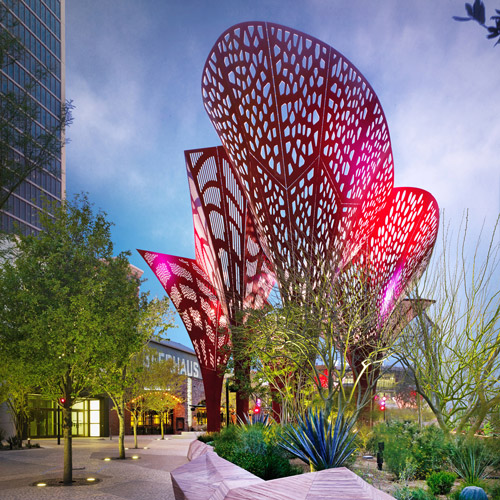Bud Cope doesn’t like to brag about his job.
“I’m kind of the chief cook and bottle washer, because so many things fall under my responsibility,” he says.
“So many things” might be a bit of an understatement. As chief real estate development officer for Williams-Sonoma, Cope is responsible for the development of all of the retail stores and workplaces for the fabled kitchen brand, as well as associated companies that include Pottery Barn, west elm, Mark and Graham, and Rejuvenation. His team of 50 internal people—and “an army of contractors”—has between 200 and 300 projects going on at any one time, some of which are planned three to four years out.
“In a year, we might have 100 to 150 projects, from our office buildings, to our global retail expansion, to our domestic, continental US projects,” he says.
Cope, who has been with Williams-Sonoma for nearly 30 years, describes the company as the crossroads of culture and art—something that keeps him and his team constantly energized.
Cope says innovation is at the heart of why the company exists. That sentiment doesn’t just apply to products, but also how the brands physically present themselves to shoppers at their retail locations.
“Williams-Sonoma is all about keeping people happy—making them productive, improving peoples’ lives at home, and ensuring they have great customer experiences in our retail stores,” he says.
Unlike most other retailers, which create “prototype” stores and build each new retail site to match that model, Williams-Sonoma takes a different approach. “We pay attention to where we’re doing stores and make sure that there’s an element of local architecture or a nod to what the town is known for,” Cope says. “We step back and integrate elements of the building and salvage as much of the building’s spirit as we can.”


Cope says customers appreciate this extra effort. “They connect to our store in a more meaningful way,” he says. “They see that we’re sustainable in our approach and local in our strategy. We believe it is the way most stores will be built in the future.”
That special touch isn’t restricted to the retail environment. One of Cope’s major projects over the past few years has been the development of west elm’s new corporate offices in Brooklyn, which opened in August 2016. It’s in a building called Empire Stores, which got its start as the original distribution point for all coffee entering the United States.
“When we took over the building, it had been abandoned for over 50 years,” he says. “There were coffee beans on the floor and inventory numbers written in crayon on the columns. There were shoots and pulleys and a lot of infrastructure for how the coffee beans made it through the warehouse. We’re keeping some of those elements and repurposing those as fixtures, art installations, and even building materials such as flooring. This will keep the story of the building alive.”
The office building will also feature art installations from some of west elm’s top suppliers around the world, an indication of how much Williams-Sonoma values input from the people and organizations with which it works.
DID YOU KNOW?
The west elm building project in Brooklyn actually led to another innovation for Bud Cope’s team and the Williams-Sonoma brand—Cope’s team helped conceive west elm’s newest brand, “west elm Workspace.” It’s a line of commercial office furniture that’s now available to the public, and will be used throughout the Brooklyn office space.
“Everything in there is ours,” Cope says, noting that it turned the entire office building into a living, breathing state-of-the-art showroom. “We’re super proud of that. There’s nothing else like it.”
“We have a philosophy that the best ideas come from someone else,” Cope says. “We always want to bring new people on projects to see what they come up with that we might not have thought of ourselves.”
He credits this philosophy to Williams-Sonoma founder Chuck Williams and the company’s long-term chairman, Howard Lester, who passed away in 2010 after growing the company from $4 million in sales to more than $3.4 billion.
“Chuck was really my mentor when I first started with the company,” Cope says. “He wanted to know what everybody thought about every product.” Lester, he adds, took that to the next level.
“He always challenged us to think differently and be willing to try new things.” An example being the Pottery Barn chain, which was initially acquired as a real estate investment and has since become an American institution.
As the company has expanded over the years to fill new markets, Cope and his team now find themselves dealing with Williams-Sonoma’s multiple brands on a daily basis. He says that’s one of the best things about his job.
“We’re one of the few teams who get to work on all the brands,” he says. Each brand may have a different set of customers, aesthetics, or even culture, but Cope says they all share the same overall message of creating the best customer experience and improving their clients’ quality of lives.
“That breathes through all of our brands,” he says. “That’s our mission as a company.”
Working with multiple brands also helps strengthen the company overall. Cope says it allows the company to share the best practices from each, while still staying within the parameters of what each brand needs to be.
“My team all works under one roof, so we can see where the opportunities are and learn from each project,” Cope says, adding that identifying those opportunities is a continual learning experience that he relishes. “I love to listen. It’s an opportunity for me to constantly travel the world, see what’s going on, and share with people what our philosophy is and what our dreams are. It’s a great, ever-changing platform for growth for me, my team, and our company.”


